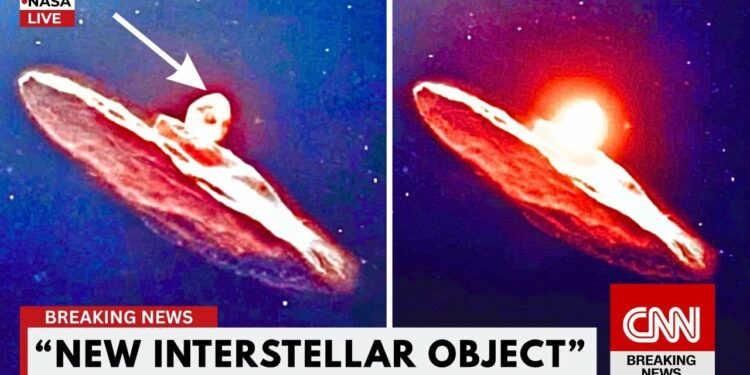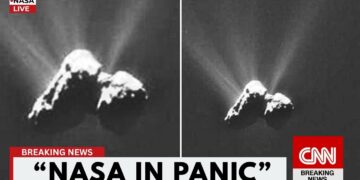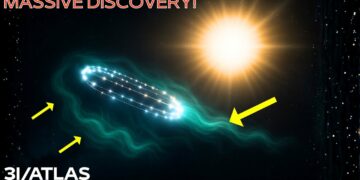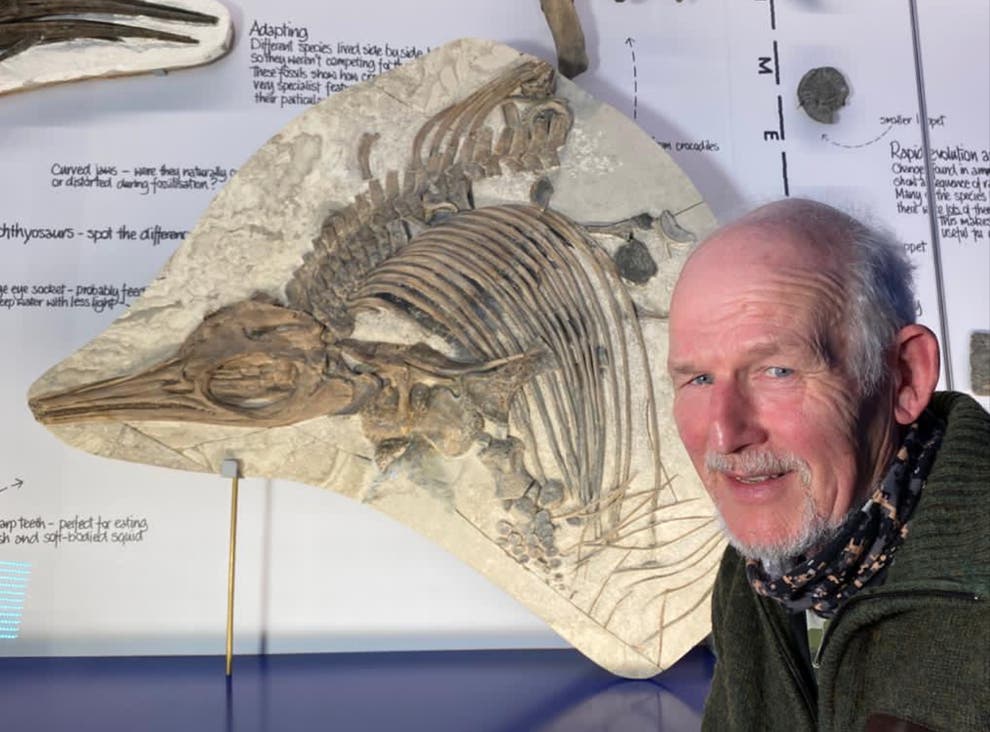On September 12, 2025, a colossal interstellar object, nearly 100 times larger and more luminous than the comet 3I/Atlas, was detected by the Swan instrument aboard the SO spacecraft. This discovery sparked immediate global observations, with Australian comet hunter Michael Metiatso capturing a breathtaking image within 48 hours, leaving scientists in awe. Unlike any known comet, this object, blazing toward the sun with unprecedented ferocity, has ignited debates among astronomers, some calling it the most significant interstellar object since ‘Oumuamua. Its arrival, coinciding with 3I/Atlas’s approach to the sun, raises questions about whether this timing is mere coincidence.
Astonishing Physical Features
The object’s tail stretches approximately 2.5 degrees across the sky—five times the width of the full moon as seen from Earth—making 3I/Atlas’s tail appear insignificant by comparison, like a matchstick’s flame next to a wildfire. This immense tail suggests an extraordinary release of material or energy, far exceeding typical cometary outgassing. Some speculate this could indicate a controlled or directed phenomenon rather than simple solar heating. Its brightness and sharply defined tail make it one of the most visually striking objects ever observed, a glowing sphere slicing through the cosmic dark.
The International Astronomical Union quickly classified it as C/2025 R2 (Swan), after its discovery instrument. Unlike 3I/Atlas, which originates near the galactic core, Swan’s trajectory from Aquarius suggests they are unrelated, deepening the mystery of two interstellar objects arriving within months of each other, both on course to meet the sun simultaneously.
Cosmic Coincidence or Coordination?
Swan’s perihelion, its closest approach to the sun, will occur at roughly 150 million km, nearly the same distance as Earth’s orbit, just days before 3I/Atlas passes at 23 million km. This 50-million-km gap is minuscule on a cosmic scale, akin to two bullets passing inches apart. In October 2025, both objects will vanish behind the sun’s glare, untrackable by Earth-based telescopes for weeks. This blackout has astronomers bracing for an unprecedented natural experiment, with possibilities ranging from gravitational interactions to collisions or even deliberate maneuvers.
Unsettling Properties
3I/Atlas has already stunned scientists with its pure nickel composition, lacking the iron typical of meteoritic material, and a 10-gigawatt energy output equivalent to 50 nuclear power plants. Its tail, a narrow, collimated jet, suggests controlled propulsion rather than chaotic outgassing, with a color shift from red to green at perihelion, which Harvard astrophysicist Avi Loeb calls “thrust modulation,” hinting at active trajectory adjustments.
Swan, however, is even more formidable. Its core emits over 10,000 gigawatts per second—comparable to humanity’s total energy consumption—suggesting a controlled reactor rather than a natural cometary nucleus. A sheath of ionized plasma surrounds its core, dynamically deflecting solar wind, while periodic brightness changes hint at bursts of propulsion, possibly from a high-efficiency plasma drive. Spectral analysis reveals a mix of nickel, cobalt, carbon dioxide, and carbon monoxide, a combination requiring extreme temperatures and magnetic confinement not seen in natural comets.
A Returning Visitor?
NASA and JPL calculations suggest Swan follows a 22,554-year orbit, meaning its last visit coincided with the end of the last Ice Age, when humanity began agriculture and built monumental stone structures. This raises unsettling questions: are ancient monuments like the Great Pyramid or Stonehenge encoded warnings of such celestial events? Their precise alignments with stars like Orion might reflect observations of a similar visitor, its blazing tail spanning five moons, prompting ancient civilizations to record its cycle in stone.
Speculation Beyond Science
Some researchers propose these objects are not comets but autonomous probes. 3I/Atlas, with its nickel composition and controlled emissions, could be a scout, while Swan, with its immense power and plasma shield, might be a command vessel, part of a coordinated mission. Theories range from Swan recovering 3I/Atlas’s data to the possibility of rival probes converging on the sun for an unknown resource—its magnetic field, gravitational potential, or energy output.
Humanity’s recent signals, from TV broadcasts to Voyager’s golden records, may have announced our presence to distant listeners. ‘Oumuamua in 2017, 3I/Atlas, and now Swan could represent a sequence: observation, data collection, and a commanding response. As both objects vanish behind the sun, humanity awaits their reemergence, which could reveal gravitational shifts, collisions, or deliberate course changes.
A Call to Attention
The silence from major space agencies like NASA and ESA is striking, with no government treating these events as global concerns. This quiet is dangerous. Whether natural or artificial, these objects could redefine our understanding of comets, interstellar matter, or even intelligent design. Ignoring them risks missing a pivotal moment in human history. The cosmos is speaking, and October 2025 may mark a turning point—an invitation, a test, or a warning. As these travelers approach the sun, we must watch, question, and prepare for what emerges.
























